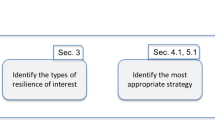Abstract
To assess in quantitative terms the “resilience” of systems, it is necessary to ask first what is meant by “resilience”, whether it is a single attribute or several, which measure or measures appropriately characterise it. This chapter covers: the technical meanings that the word “resilience” has assumed, and its role in the debates about how best to achieve reliability, safety, etc.; the different possible measures for the attributes that the word designates, with their different pros and cons in terms of ease of empirical assessment and suitability for supporting prediction and decision making; the similarity between these concepts, measures and attached problems in various fields of engineering, and how lessons can be propagated between them.
Access this chapter
Tax calculation will be finalised at checkout
Purchases are for personal use only
Similar content being viewed by others
Notes
- 1.
Including “system design failures”: all components function as specified, but it turns out that in the specific circumstances the combination of these specified behaviours ends in system failure: the system’s design was “faulty”.
- 2.
Although many authors point out that accidents caused by single component failures are still common. A component failure occurs in a system design that happens to omit those defences that would prevent that specific failure from causing an accident.
- 3.
A conceptual problem arises here, which will recur in different guises throughout this discussion. To use an example, suppose that two computers are made to operate in an environment with high levels of electromagnetic noise. Of the two, computer A is heavily shielded and mostly immune to the noise. The other one, computer B, is not, and suffers frequent transient failures, but always recovers from them so that correct service is maintained. The two thus prove equally dependable under this amount of stress, but many would say that only B is so dependable thanks to its “resilience”: A just avoids disturbances; only B “bounces back” from them. Should we prefer B over A? Suppose that over repeated tests, B sometimes fails unrecoverably, but A does not. Clearly, A’s lack of “resilience” is then not a handicap. Why then should we focus on assessing “resilience”, rather than dependability? Or at least, should we not define the quality of interest (whether we call it “resilience” or not) in terms of “correct behaviour despite pressure to behave incorrectly”? An answer might be that the resilience mechanisms that B has demonstrated to have will probably help it in situations in which A’s single-minded defence (heavy shielding) will not help. But then the choice between A and B becomes an issue of analysing how much better than A B would fare in various situations, and how likely each situation is. Measures of “resilience” in terms of recovery after faltering are just useful information towards estimating measures of such “dependability in a range of different situations”.
- 4.
“Masking” usually meaning that the externally observed behaviour of the system shows no effect of the fault.
- 5.
That is, even for many deterministic systems, their behaviour is complex enough that the knowledge we can build about them is only statistical or probabilistic. For instance, many software systems (deterministic in intention) have a large enough state space that many failures observed in operation appear non-deterministic—they cannot be reproduced by replicating the parts of the failure-triggering state and inputs that are observable [390].
- 6.
If “accomplishment” has a numerical measure, e.g., throughput of a system, the system’s performability is defined by the probability distribution function of this measure.
- 7.
U.S. Navy aircraft carriers exploited redundancy for safety long before Rochlin and his co-authors studied it. On the other hand, their study prompted more organisations to recognise forms of redundancy in their operation, and protect them during organisational changes, and/or to consider applying redundancy.
Acknowledgments
This work was supported in part by the “Assessing, Measuring, and Benchmarking Resilience” (AMBER) Co-ordination Action, funded by the European Framework Programme 7, FP7-216295. This article is adapted from Chap. 15 of the “State of the Art” report produced by AMBER, June 2009.
Author information
Authors and Affiliations
Corresponding author
Editor information
Editors and Affiliations
Rights and permissions
Copyright information
© 2012 Springer-Verlag Berlin Heidelberg
About this chapter
Cite this chapter
Strigini, L. (2012). Fault Tolerance and Resilience: Meanings, Measures and Assessment. In: Wolter, K., Avritzer, A., Vieira, M., van Moorsel, A. (eds) Resilience Assessment and Evaluation of Computing Systems. Springer, Berlin, Heidelberg. https://doi.org/10.1007/978-3-642-29032-9_1
Download citation
DOI: https://doi.org/10.1007/978-3-642-29032-9_1
Published:
Publisher Name: Springer, Berlin, Heidelberg
Print ISBN: 978-3-642-29031-2
Online ISBN: 978-3-642-29032-9
eBook Packages: Computer ScienceComputer Science (R0)




